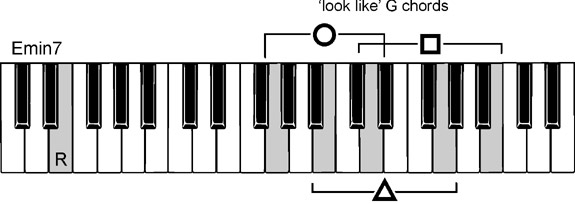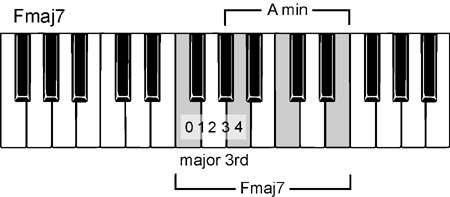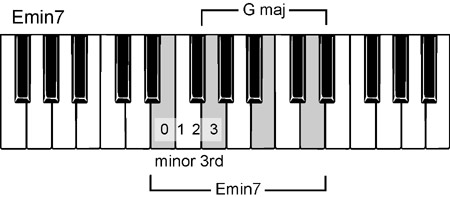Musicarta Modes - Mediant Substitution
Mediant Substitution (Part 1)
Mediant substitution is a simple but powerful technique for making all your chord sequences sound more sophisticated.
Download up-to-date MIDI files for this page.
Here’s the module riff.
The right hand in this riff plays only A minor and G chords, but mediant substitution makes it sound much more advanced.
NOTE: Some computer
systems do not represent sharp and flat signs as entered by the author. ë indicates a flat sign and ì a sharp.
Mediant substitution
Let’s recap a Module Four i-ëVII (One minor/Flat Seven) modal minor pair – A minor and G.

Listen to what happens if, instead of playing the root of the G major chord in your left hand, you play the note a third down – E.

You can hear a more filled-out sound. If we just played E minor chords (following the root in the left hand), we would have this.
Our mediant substitution ‘slash chord’ is definitely an improvement: we’re getting the best of both worlds. Listen to it again for comparison.
A ‘slash chord’ is a chord with a note that’s not the chord root, in the bass.
Writing down the mediant substitution chords
In the last MS (written-out music) example above you can see that our mediant substitution chord is indicated using two different chord symbols:
- As a slash chord – “G over E”.; and
- As Em7 (E minor seven)
The first chord symbol – slash chord G over E – describes what the chord looks like and how you can easily make it: you play a G major triad in the right hand and the note E in the bass. We will use this formula to make lots of great-sounding seventh chords
The second chord symbol – Em7 (E minor seven) – is the ‘proper’ name for the chord. Seventh cords are four-note chords
Substituting another pair of inversions
Let’s use the same mediant substitution process on another pair of A minor and G inversions. Play the chords ‘straight’ first.

Now, shift the bass down a third (mediant substitution) for both chords.

You see here another way of writing slash chords here. They are still called “A minor over F” and “G over E”, but the bass note is written after a slash and not underneath it.
In the second half of the MS, you see the proper names of the chords: “F major 7” and “E minor 7”. Notice the alternative way of writing the E minor 7 chord symbol – Emin7 instead of Em7. You will find both versions in pop sheet music.
Minor and major seventh chords
A seventh chord is a four-note chord. In its simplest form, it is a root position triad (root, third, fifth) with another note a third above the fifth – the seventh note counting up the scale from the root.
Here are our two seventh chords – F major 7 and E minor 7 – in root position.


In our all-white-key A Aeolian, you can play these seventh chords (in root position) by simply playing a key, missing one, playing one and so on until you have four notes.
There are four varieties of seventh chord. For a full explanation and an essential keyboard drill for learning the five types, visit Musicarta’s Seventh Chords page.
Making seventh chords with mediant substitution
We have discovered that
A MINOR SEVENTH CHORD looks like:
The root plus a major chord built on the note a minor third higher

Any of the G inversions over an E will make and E minor 7 chord. Play the root in the left hand and any three-note inversion in the right.
A MAJOR SEVENTH
CHORD looks like:
The root plus a minor chord built on the note a major third higher

Any A minor inversion over the F would make an F major 7 chord. The keyboard shows only the F major 7 chord in this Module’s riff. Invert the A minor chord to make the other major seventh chord inversions.
Trying out mediant substitution chords
Mediant substitution chords are chords you ‘try out’. They will nearly always harmonise your existing melody in an interesting, even improved, way.
Mediant substitution is a simple process with a fancy name. You create mediant substitution chords – to try them out – by dropping the root of the existing chord a third.
You drop the root of a major chord a minor third (three semitones) to get a substitute minor seventh chord on the new root:

You drop the root of a minor chord a major third (four semitones) to get a substitute major seventh chord on the new root:

To use this method, you need to make sure you are working with the root position triad of the chord that you are substituting.
After that, the new root will usually drop an octave or two into the left hand, and the right hand will play whatever inversion of the triad the melody/top note makes necessary.
These mediant substitution seventh chords make the modal chord sequences sound a lot more sophisticated. In the next module, we practice the process on other i-¨VII (One minor/Flat Seven) chord pairs. Dropping seventh chords into chord sequences will soon become second nature to you!
|
OUT NOW! |
THE MUSICARTA BEAT & RHYTHM WORKBOOK At last! An effective approach to keyboard rhythm & syncopation skills. Learn more! |
ONLY $24.95! |
MODES |
The MusicartaA methodical approach to keyboard syncopation for
|
PUBLICATIONS
exciting keyboard
creativity courses
CHORDS 101
WORKBOOK

~HANON~
video course

Musicarta
Patreon
PENTATONICS
WORKBOOK
video course

Creative Keyboard
video course

BEAT AND RHYTHM
WORKBOOK

- Volume 1 -

12-BAR PIANO
STYLES WORKBOOK

MUSICARTA MODES
WORKBOOK

PIANO STYLE

CANON PROJECT
video course

VARIATIONS
video course


- Piano Solo -
video course

- Piano Solo -


YouTube playlists





 THE LOGO
THE LOGO
